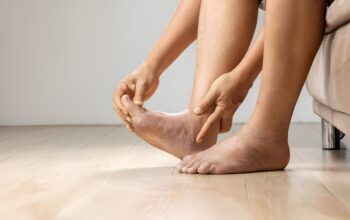An eye twitch is an involuntary spasm or movement of the eye muscles or eyelid. Medical professionals often refer to it as blepharospasm. This phenomenon is more common in the upper eyelid. The eyelid typically twitches intermittently, often every few seconds, and this usually lasts for just a minute or two.
Common Types of Eye Twitches
Eye twitches can be categorized into three main types.
The first type, minor eyelid twitching, is commonly associated with everyday factors such as lack of sleep, stress, or caffeine consumption. It can also occur if the eye’s surface (cornea) or the inner eyelid lining (conjunctiva) becomes irritated.
Benign essential blepharospasm typically emerges in mid to late adulthood and progressively worsens. It affects approximately 2,000 individuals in the U.S. annually, with women being twice as likely to experience it as men. While not a severe health issue, in more advanced cases, it can disrupt daily activities.
This condition begins with continuous blinking or eye irritation and can escalate to increased light sensitivity, blurred vision, and facial spasms. In extreme cases, the spasms can be so intense that the eyelids remain closed for several hours. Both genetic factors and environmental influences are thought to contribute to its development.
The third type, hemifacial spasm, is rarer and involves muscles around the mouth and eyelid. This type typically affects only one side of the face and is most commonly caused by an artery compressing a facial nerve.
Eye Twitches causes
- Fatigue or insufficient sleep
- Stress or anxiety
- Physical exercise
- Caffeine intake
Additional Factors that Can Cause Eyelid Twitching:
- Eye discomfort, strain, or a scratched cornea
- Dry eyes
- Environmental factors like wind, intense light, or air pollution
- Neurological conditions such as multiple sclerosis
- Alcohol use
- Smoking or exposure to tobacco smoke
- Certain medications, including topiramate, clozapine, and flunarizine
- Sensitivity to light
- Uveitis, which is the inflammation of the eye’s middle layer
- Blepharitis, an inflammation of the eyelid
- Conjunctivitis, commonly known as pinkeye
- Occurrences of migraine
Eye Twitches treatment
For minor twitches, they often resolve without intervention. Adequate rest, along with reducing alcohol, tobacco, and caffeine, can be beneficial. If twitches are due to dry or irritated eyes, over-the-counter artificial tears may help.
Benign essential blepharospasm doesn’t have a cure, but symptoms can be managed under medical guidance. The most common treatment is the use of botulinum toxin injections (such as Botox, Dysport, Xeomin), which are also effective for hemifacial spasms.
These injections are administered in small doses into the eye muscles to alleviate spasms. The effects are temporary, lasting a few months, and repeated treatments are necessary.
For less severe cases, doctors may recommend medications like Clonazepam (Klonopin), Lorazepam (Ativan), or Trihexyphenidyl hydrochloride (Artane, Trihexane, Tritane), which typically provide short-term relief.
Other alternative treatments include biofeedback, acupuncture, hypnosis, chiropractic care, nutrition therapy, and tinted glasses. However, their effectiveness hasn’t been conclusively proven by scientific studies.
In certain situations, surgery might be an option. A myectomy, which involves removing some muscles and nerves around the eyelid, can be performed. Additionally, surgery can help relieve the pressure of an artery on the facial nerve, causing hemifacial spasm. While the results of surgery are often permanent, it carries the usual risks of complications associated with any surgical procedure.







